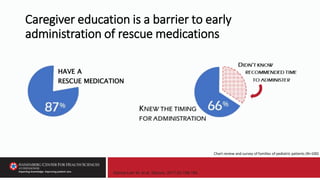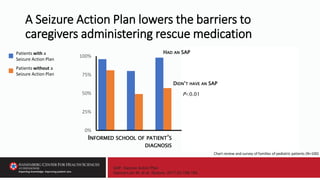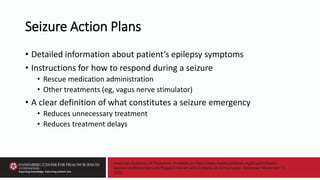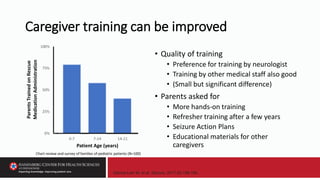This document provides an overview of a presentation on care for seizure emergencies. It introduces the faculty members Gregory D. Cascino and Juliann M. Paolicchi and discusses topics that will be covered, including an overview of care for seizure emergencies, the pediatric perspective, advances in prehospital management of acute repetitive seizures, focusing on caregivers and healthcare providers, and optimal management of seizure emergencies. It also lists modules that will be presented on status epilepticus disease burden, guidelines for managing status epilepticus, and the pediatric perspective.










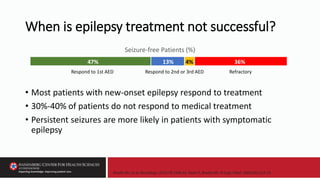






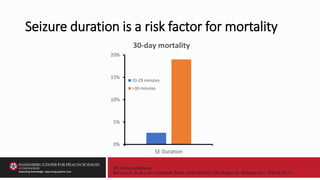








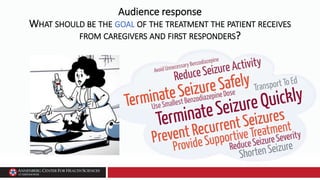









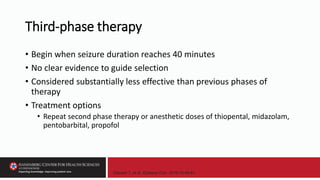





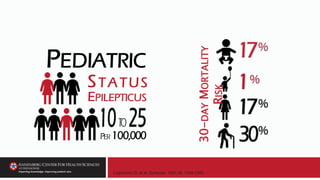














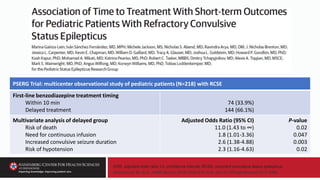

![Stredny CM, et al. Seizure. 2018;58:133-140. doi: 10.1016/j.seizure.2018.04.011.
Rapid initiation and escalation of SR treatment has been associated with shortened seizure duration
and more favorable outcomes. Current evidence-based guidelines for management of status
epilepticus propose medication algorithms with suggested times for each management step. [PSERG
and other studies have shown that] time to antiseizure medication administration for pediatric
status epilepticus remains delayed in both the pre- and in-hospital settings. Barriers to timely
treatment include suboptimal preventive care, inaccurate seizure detection, infrequent or restricted
use of home rescue medications by caregivers and pre-hospital emergency personnel, delayed
summoning and arrival of emergency personnel, and use of inappropriately dosed medications….
Conclusion: Improved preventive care, seizure detection, and rescue medication education may
advance pre-hospital management….](https://image.slidesharecdn.com/58750-79slides-230509222408-39e295fa/85/58750-79_Slides-pptx-60-320.jpg)
![Stredny CM, et al. Seizure. 2018;58:133-140. doi: 10.1016/j.seizure.2018.04.011.
Rapid initiation and escalation of SR treatment has been associated with shortened seizure duration
and more favorable outcomes. Current evidence-based guidelines for management of status
epilepticus propose medication algorithms with suggested times for each management step. [PSERG
and other studies have shown that] time to antiseizure medication administration for pediatric
status epilepticus remains delayed in both the pre- and in-hospital settings. Barriers to timely
treatment include suboptimal preventive care, inaccurate seizure detection, infrequent or restricted
use of home rescue medications by caregivers and pre-hospital emergency personnel, delayed
summoning and arrival of emergency personnel, and use of inappropriately dosed medications….
Conclusion: Improved preventive care, seizure detection, and rescue medication education may
advance pre-hospital management….](https://image.slidesharecdn.com/58750-79slides-230509222408-39e295fa/85/58750-79_Slides-pptx-61-320.jpg)
![Stredny CM, et al. Seizure. 2018;58:133-140. doi: 10.1016/j.seizure.2018.04.011.
Rapid initiation and escalation of SR treatment has been associated with shortened seizure duration
and more favorable outcomes. Current evidence-based guidelines for management of status
epilepticus propose medication algorithms with suggested times for each management step. [PSERG
and other studies have shown that] time to antiseizure medication administration for pediatric
status epilepticus remains delayed in both the pre- and in-hospital settings. Barriers to timely
treatment include suboptimal preventive care, inaccurate seizure detection, infrequent or restricted
use of home rescue medications by caregivers and pre-hospital emergency personnel, delayed
summoning and arrival of emergency personnel, and use of inappropriately dosed medications….
Conclusion: Improved preventive care, seizure detection, and rescue medication education may
advance pre-hospital management….](https://image.slidesharecdn.com/58750-79slides-230509222408-39e295fa/85/58750-79_Slides-pptx-62-320.jpg)
![Stredny CM, et al. Seizure. 2018;58:133-140. doi: 10.1016/j.seizure.2018.04.011.
Rapid initiation and escalation of SR treatment has been associated with shortened seizure duration
and more favorable outcomes. Current evidence-based guidelines for management of status
epilepticus propose medication algorithms with suggested times for each management step. [PSERG
and other studies have shown that] time to antiseizure medication administration for pediatric
status epilepticus remains delayed in both the pre- and in-hospital settings. Barriers to timely
treatment include suboptimal preventive care, inaccurate seizure detection, infrequent or restricted
use of home rescue medications by caregivers and pre-hospital emergency personnel, delayed
summoning and arrival of emergency personnel, and use of inappropriately dosed medications….
Conclusion: Improved preventive care, seizure detection, and rescue medication education may
advance pre-hospital management….](https://image.slidesharecdn.com/58750-79slides-230509222408-39e295fa/85/58750-79_Slides-pptx-63-320.jpg)
![Stredny CM, et al. Seizure. 2018;58:133-140. doi: 10.1016/j.seizure.2018.04.011.
Rapid initiation and escalation of SR treatment has been associated with shortened seizure duration
and more favorable outcomes. Current evidence-based guidelines for management of status
epilepticus propose medication algorithms with suggested times for each management step. [PSERG
and other studies have shown that] time to antiseizure medication administration for pediatric
status epilepticus remains delayed in both the pre- and in-hospital settings. Barriers to timely
treatment include suboptimal preventive care, inaccurate seizure detection, infrequent or restricted
use of home rescue medications by caregivers and pre-hospital emergency personnel, delayed
summoning and arrival of emergency personnel, and use of inappropriately dosed medications….
Conclusion: Improved preventive care, seizure detection, and rescue medication education may
advance pre-hospital management….](https://image.slidesharecdn.com/58750-79slides-230509222408-39e295fa/85/58750-79_Slides-pptx-64-320.jpg)








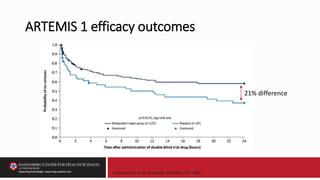













![Glauser T, et al. Epilepsy Curr. 2016;16:48-61.
…approaches to the pharmacologic treatment of status epilepticus
continue to vary dramatically [and] patients still receive inadequate
treatment for a variety of reasons including…use of inefficient therapies
such as sedatives and paralytics, and administration of insufficient
anticonvulsant doses.](https://image.slidesharecdn.com/58750-79slides-230509222408-39e295fa/85/58750-79_Slides-pptx-87-320.jpg)


